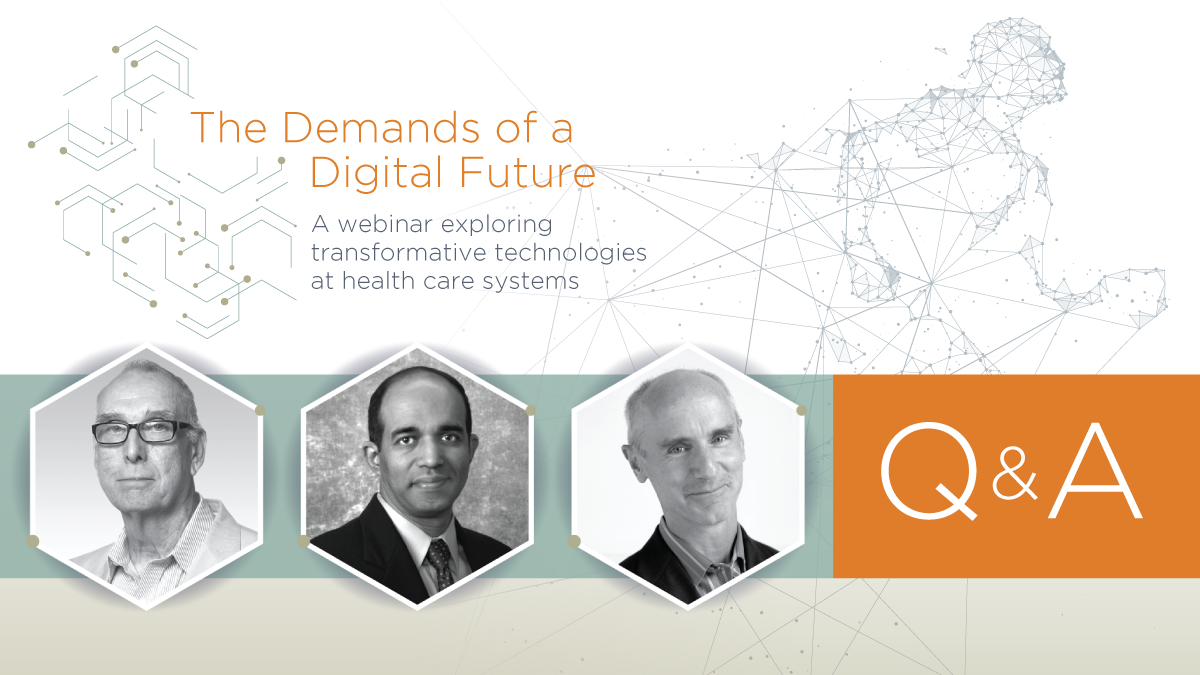How can machine learning be used to improve clinical alerts? How can blockchain technology aid in securing health data that is exchanged? And where do medical imaging systems fit into the transition to the real-time health system?
These are some of the digital transformation questions submitted by the audience from “The Demands of a Digital Future” webinar, which explored digital technologies at health care systems.
The webinar, hosted by the Center for Connected Medicine (CCM), focused on the opportunities and challenges for health systems to make use of the vast amounts of data available to improve outcomes and efficiency.
Three expert panelists were featured in the webinar and answered questions from the audience:
- Srinivasan Suresh, MD, MBA, Chief Medical Information Officer of UPMC Children’s Hospital of Pittsburgh.
- Chris Janson, Senior Product Marketing Manager of Optical Networks at Nokia.
- Barry Runyon, Vice President of Research at Gartner.
The questions and answers provided by the panelists are below.
If you missed the webinar, read a recap and watch a recording of the webinar.
“How are patients at home engaged, both acutely and over time? What role does the informal family caregiver play in adoption/engagement in high-cost and high-risk patients? And what does your mapped workflow framework to engage informal caregivers look like?”
Dr. Suresh: The engagement process for patients and caregivers at home is an ongoing initiative and evolving. Currently, the engagement is through an in-person conversation by the care manager in the hospital setting with the family just prior to discharge from the acute care unit.
The in-person conversation is followed by a phone conversation a few days later with the parent or caregiver to ensure (a) compliance with follow up appointment with primary care physician, (b) adherence to medications and other instructions that were provided at time of hospital discharge, and (c) to address any care issues or any other questions the family may have. We are evaluating a text-based interaction with families whose children have a high probability of avoidable readmissions.
“How accurate are the alerts that screen for child abuse and how does machine learning improve these alerts?”
Dr. Suresh: The purpose of the “child abuse alerts” is not necessarily to diagnose child abuse, but to alert us to the possibility of child physical abuse, based on presenting signs and symptoms. The alerts remind the emergency provider to perform the appropriate work-up in these suspected cases, such as lab tests, x-rays, involvement of social workers, consultation with our child advocacy team, or filing a “childline,” which is a state mandated report.
We have set up the clinical decision support system in such a way that it is very sensitive to pick up every single case of suspected physical abuse. This may not lead to high specificity, but that trade-off is acceptable. We have also been successful in reducing alert fatigue. At this point, we are not using machine learning (ML) to create these alerts. There is certainly an opportunity to use ML to refine the child abuse alert. We will be using ML for another clinical decision support initiative – developing an alert for clinical deterioration for patients in our cardiac intensive care unit.
“Do you foresee blockchain being used in the secure exchange of data or the connection of public and private systems?”
Mr. Janson: At this point, I am not aware of blockchain in use within the healthcare setting. Blockchain is usually thought of as a distributed ledger for bitcoin. That’s not to say it may evolve into some future role as a way to certify payments among providers.
We encourage adoption of a defense-in-depth security architecture: multiple defenses against threats that could attack the network, the data center or the user. As an example, protection mechanisms should be deployed in multiple layers of the OSI stack, including IPSec, Network group encryption and layer 1 encryption.
“Most of the vast amount of info that is fed into these systems is done by health care providers who are not IT professionals who are year by year given more devices to use to share their information. How can we keep pace with more IT support for these increasing demands?
Mr. Janson: A similar concern is shared by people in other sectors such as government, railroads, and power utilities. These enterprises also face an increasing number of devices peppered throughout their operations, often exceeding the capabilities or knowledge of existing staff.
The nature of the so-called Internet of Things (IoT) is that many small computing devices provide control or reporting of data on something important to the organization’s central mission. In doing so, the IoT returns value, which should be recognized as a strategic asset. Organizations, including healthcare systems, should invest in appropriate levels of staff or outsourced support to keep pace because it is in their best interest.
The results reported by Dr. Suresh in this webinar is evidence of the value and need for that support. The improvements he reported in patient outcomes and efficiencies prove the need to support evolving healthcare IT.
“What part do you see for medical imaging platforms to assist in this transition to real-time health systems, and which players are already doing a good job of this? What gaps would you like to see addressed on the medical imaging software side?”
Mr. Runyon: The medical imaging platform that most supports a healthcare provider’s transformation to a real-time health system (RTHS) is the vendor-neutral archive (VNA). The VNA is now central to the healthcare provider’s enterprise imaging strategy, and it is evolving to include all unstructured clinical content, in addition to its traditional imaging role.
The VNA is no longer a passive archive of DICOM images and studies, but rather, includes all manner of unstructured clinical content required to support an RTHS. The VNA was originally a market response to the prodigious storage growth associated with picture archiving and communication systems (PACS), and the cost and complexity of PACS migration. Since then, the VNA value proposition has evolved to include standards-based information access and sharing, universal image viewing, and sophisticated workflow capabilities. More recently, the VNA has been promoted for its contributions to operational efficiency, interoperability and the clinical benefits that it enables.
The VNA is critical to the healthcare provider’s ability to leverage the wealth of clinical insight trapped within medical images and other unstructured clinical content surrounding patient care, including that captured across vendor. It is also essential for a healthcare provider to get control of the fragmented data surrounding the patient, which has and will experience ownership issues by vendor. Leveraging the VNA is a step in the right direction to enable the transition of control from vendors back to the enterprise.
The domains of enterprise content management and medical imaging are now actively converging within the VNA platform. Gartner’s long-term view is that this convergence will continue in healthcare, and while the name of the technology may change, the functional need for neutral storage of healthcare data will endure and grow.
The core capabilities of the VNA surround vendor independence and the adoption of industry standards. These characteristics complement the mission of the RTHS — whose justification for existence is enterprise-wide situational awareness achieved through the progressive adoption of industry interoperability standards for patient-related data, and the timely application of up-to-date operational intelligence. The VNA is as much a response to inaccessible and siloed data as the RTHS is a response to the current state of the healthcare delivery organization (HDO) — where awareness is often limited, information is not easily shared, workflows and business processes are disconnected, and data is not available when and where it needs to be.
The RTHS collects and analyzes data gathered during the course of doing business. It uses that information to optimize workflows and business processes, balance resources with demand, and improve decision making. The VNA is not a passive actor in this process, but a rich source of patient history and event data — a key information source providing visibility into important patient-related activities and event data to satisfy revenue, cost, quality and patient experience expectations. The VNA is an important component of an RTHS migration plan — where the awareness must be addressed, and consolidation, standardization and integration play a critical role in adopting the RTHS vision.



